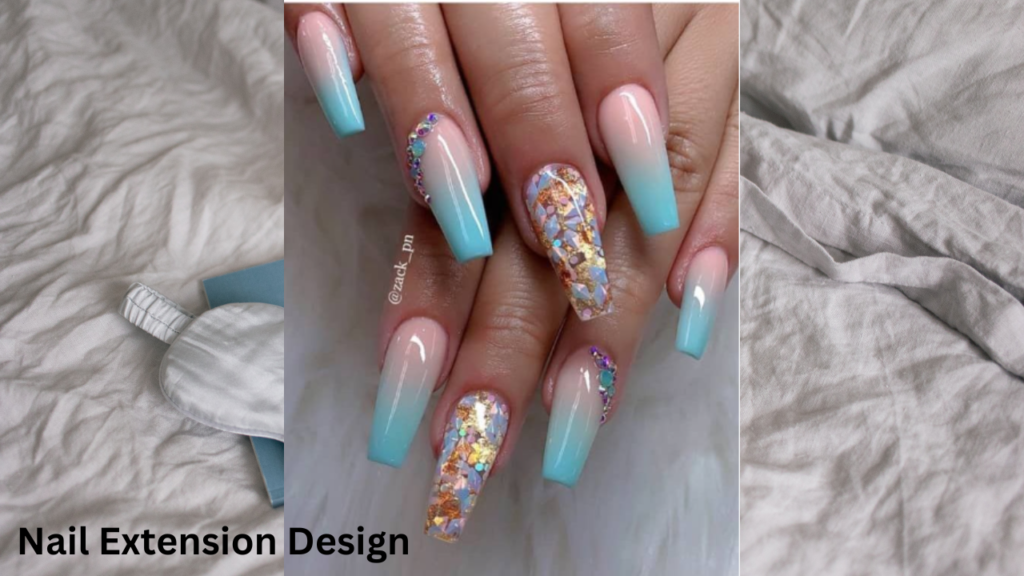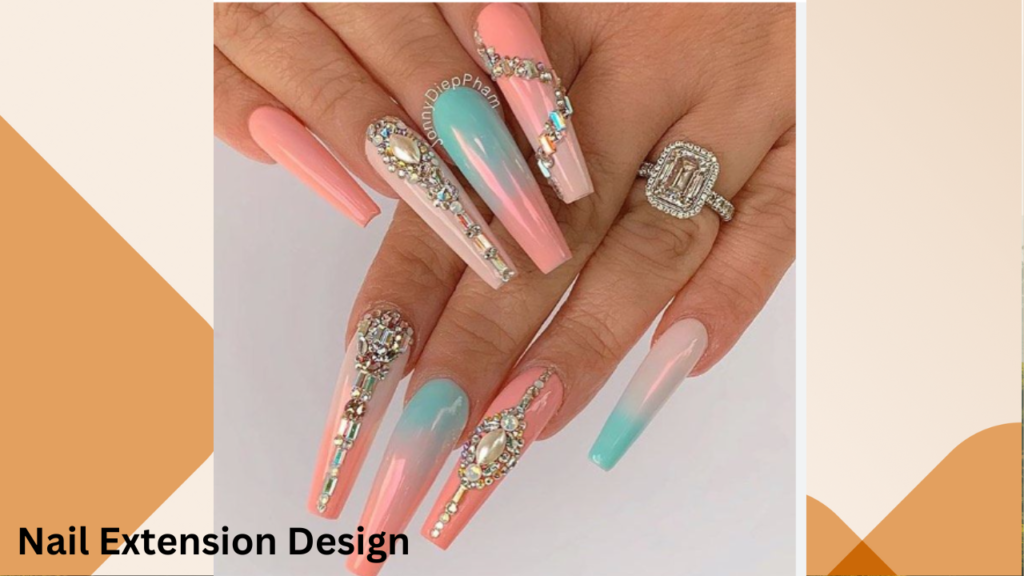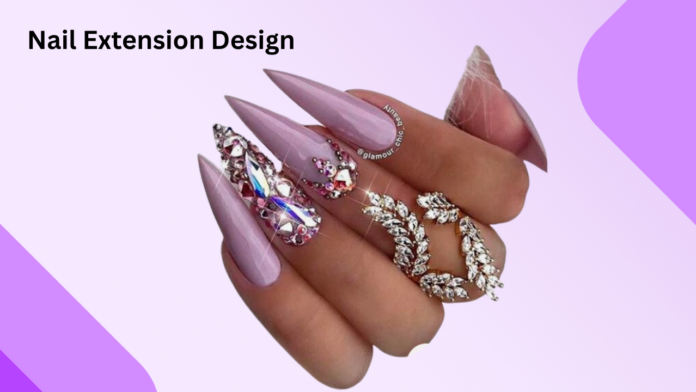1.Introduction
Overview of nail extensions: Explain what nail extensions design are, their purpose, and their popularity.
History and development:
2. Types of nail extensions Acrylic nails Definition and ingredients:
What are acrylic nails, and what materials are used? Application process: Step-by-step guide on how acrylic nails are applied. Benefits and disadvantages: Advantages and disadvantages of acrylic nails. Gel nails Definition and ingredients: Description of gel nails and their composition.
Application process: Detailed guide on the application of gel Nail Extension Design. Benefits and disadvantages: Advantages and disadvantages of gel nails.
Polygel nails Definition and ingredients: What are polygel nails, and what makes them different? Application process: Step-by-step guide to applying polygel nails.

Benefits and disadvantages: Advantages and disadvantages of polygel Nail Extension Design.
Dip powder nails Definition and ingredients: Description of dip powder nails and the materials used. Application process: Detailed instructions for applying dip powder nails. Benefits and disadvantages: Advantages and limitations of dip powder nails.
3.Nail Extension Design Trends
Classic Designs
French Tip: Traditional French manicure and modern variations.
Ombre Effect: Techniques and color combinations for the ombre look.
Modern and Trendy Designs
Glitter and Metallics: Add sparkle and shine to your nails.
Geometric Patterns: Creating sharp lines and shapes for a contemporary look.
Marble Effect: Techniques to get a marble look on nails.
Seasonal and Theme Designs
Spring/Summer Designs: Floral patterns, bright colors, and summer themes.
Fall/Winter Designs: Dark colors, holiday themes, and cozy patterns.
4.Nail Extension Application Techniques
1.Preparation
Nail preparation: Cleaning and shaping natural nails.
Cuticle care: Proper cuticle management.
2.Application methods
Acrylic nails: Detailed steps from application to finishing.
Gel nails: Comprehensive guide to applying gel extensions.
Polygel nails: Instructions for using polygel for extensions.
Dip powder nails: Process of applying dip powder and sealing it.
3.Finishing touches
Buffing and shaping: Techniques for achieving a smooth and flat surface.
Top coats and sealants: Types of top coats and their application.
5.Nail Extension Maintenance
1. Routine Care
Cleaning and Sanitizing: How to keep nail extensions clean.
Hydration and Moisturizing: The importance of keeping Nail Extension Design and cuticles hydrated.
2.Repair and Troubleshooting
Common Problems: How to handle lifting, chipping, and other issues.
Removal: Safe ways to remove nail extensions.

6.DIY vs. Professional Application DIY Application Tools and Products Required: Tools needed for nail extensions at home.
1.Step-by-Step Guide: Detailed instructions for applying nail extensions at home.
2.Safety Tips: Precautions to take when applying Nail Extension Design at home.
3.Choosing a Professional Application Salon: How to Select a Reputable Nail Salon.
4.What to Expect: An Overview of Professional Nail Extension Appointments.
5. Cost and Price: Discussion on the Cost of Professional Nail Extensions vs. DIY.
7.Nail Extension Design Inspiration Celebrity Trends: Popular Nail Designs Seen on Celebrities.
1.Fashion and Runway: How Fashion Trends Influence Nail Extension Design.
2.Cultural Influences: How Different Cultures Incorporate Unique Designs into Nail Extensions.
8.Conclusion Summary of Key Points: A Recap of Types, Trends, and Application Techniques.
The Future of Nail Extensions: Emerging Trends and Technologies in Nail Extensions.
9.Resources and References Glossary: Definitions of key terms used in nail extension design.
Further Reading: Recommended books, articles, and websites for more information.
10. Appendix Illustrations and Diagrams: Visual aids for application techniques and design ideas.
Templates and Checklists: Handy guides for DIY application and maintenance.
This structure provides a comprehensive approach to writing about nail extension designs. Each section can be expanded to reach the desired length with detailed explanations, step-by-step guides, and examples.

11.FAQs
Frequently Asked Questions About Nail Extension Designs
1.What are nail extensions?
Nail extensions are artificial enhancements applied to natural nails to add length, strength and design. They can be made from various materials such as acrylic, gel, polygel or dip powder.
2.What are the different types of nail extensions?
The main types of nail extensions are:
Acrylic nails: Made from a mixture of liquid and powder, these are durable and can be molded into any shape.
Gel nails: Applied as a gel and dried under a UV or LED lamp, providing a natural look with flexibility.
Polygel nails: A hybrid between acrylic and gel, offering the best of both worlds with ease of application and durability.
Dip Powder Nails: This involves dipping the nails in a colored powder and sealing with a top coat, which is known for its longevity and minimal curing time.
3.How long do nail extensions usually last?
Nail extensions can last from 2 to 4 weeks, depending on the type of extension, the quality of the application, and how well they are cared for.
4.Can I do nail extensions at home or should I go to a professional?
Although DIY nail extensions are possible, it is recommended to visit a professional for the best results, especially if you are new to nail extensions. Professionals have the expertise and equipment to ensure proper application and minimize the risk of damage.
5.What is the process of applying acrylic nails?
Preparation: Clean and shape natural nails, push back cuticles and apply primer.
Application: Apply nail form or tip, mix acrylic powder and liquid and shape the acrylic onto the natural nail.
Shaping: After the acrylic has dried, file and shape the nails.
Finishing: Polish the surface and apply a top coat or polish.
6.Do nail extensions damage natural nails?
Nail extensions can cause damage if not applied or removed properly. They can weaken natural nails or cause infection if they are not maintained. Proper application and maintenance, as well as periodic breaks, can help minimize damage.
7.How can I care for my nail extensions?
Keep them clean: Clean your nails regularly and avoid harsh chemicals.
Moisturize: Use cuticle oil to keep your nails and surrounding skin hydrated.
Avoid overuse: Give your nails some time to heal between extensions.
8.How can I remove nail extensions safely?
Acrylic nails: Soak acrylic in acetone until it softens, then gently remove. Avoid pulling or scraping.
Gel nails: File the top layer and soak in acetone to remove the gel.
Polygel nails: File the surface and soak in acetone or use a professional removal product.
Dip powder nails: Soak in acetone and file gently.
9.Can I design my nail extensions with different patterns?
Yes, nail extensions can be customized with different designs including glitter, ombre, floral patterns, geometric shapes, and more. Nail art can be added after the extensions have been applied.
10.What are some of the current trends in nail extension designs?
Current trends include:
Minimalistic designs: Simple lines and shapes with neutral colors.
Bold colors and patterns: Vibrant colors and intricate patterns.
3D elements: Adding gems, pearls, and other embellishments.
Seasonal themes: Designs that reflect the current season or holidays.
11.How much do nail extensions cost?
The price of nail extensions varies depending on the type, complexity of the design, and location. On average, acrylic and gel extensions can range from $30 to $60, while more elaborate designs or premium services may cost more.
12.Are there any allergies or side effects to be aware of?
Some people may experience allergies or sensitivities to the ingredients used in nail extensions. If you have allergies or sensitive skin, it is important to do a patch test or consult a professional.
Feel free to adjust the questions or add more questions based on the specific needs or concerns of the audience!



[…] to nails to improve their appearance. It usually comes in liquid form and is applied with a brush. Nail polish can add color, shine, or pattern to nails and is often used to match or complement one’s outfit or personal style. […]
[…] Nude nail paint is a popular choice in the world of nail care and fashion, known for its simplistic beauty and versatility. Basically, nude nail paint refers to a shade of nail polish that mimics the natural color of the nails or skin, offering a neutral, subtle look that is both chic and versatile. This color can vary widely from light beige and pale pink to dark brown and gray, making it suitable for a variety of skin tones and personal preferences. The appeal of nude nail paint lies in its simplicity and the way it complements a variety of outfits and styles. Unlike bold or vibrant colors that can make a statement, nude nail polish offers a more restrained and sophisticated look. […]